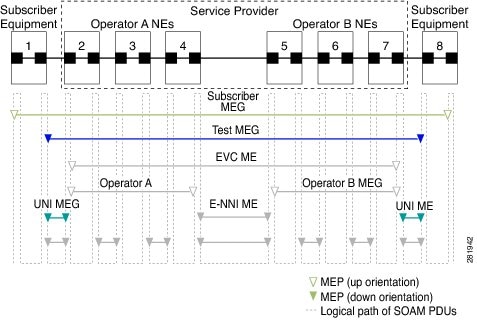Ethernet frame Delay
Measurement (ETH-DM) is used for on-demand Ethernet Operations, Administration
& Maintenance (OAM) to measure frame delay and frame-delay variation.
Ethernet frame delay
and frame delay variation are measured by sending periodic frames with ETH-DM
information to the peer MEP in the same maintenance entity. Peer MEPs perform
frame-delay and frame-delay variation measurements through this periodic
exchange during the diagnostic interval.
Ethernet frame delay
measurement supports hardware-based timestamping in the ingress direction.
These are the two
methods of delay measurement, as defined by the ITU-T Y.1731 standard, One-way
ETH-DM (1DM) and Two-way ETH-DM (2DM). However, the
Cisco ASR 901
router supports only Two-way ETH-DM.
Two-way Delay
Measurement
Two-way frame delay
and variation can be measured using DMM and Delay Measurement Reply (DMR)
frames.

Note |
Starting with
Cisco IOS Release 15.4(2)S, the DMM sessions are enhanced from 32 to 100.
|
In two-way delay
measurements, the sender MEP transmits a frame containing ETH-DM request
information and TxTimeStampf, where TxTimeStampf is the timestamp of the time
at which the DMM is sent.
When the receiver
MEP receives the frame, it records RxTimeStampf, where RxTimeStampf is the
timestamp of the time at which the frame with ETH-DM request information is
received.
The receiver MEP
responds with a frame containing ETH-DM reply information and TxTimeStampb,
where TxTimeStampb is the timestamp of the time at which the frame with ETH-DM
reply information is sent.
When the sender MEP
receives this frame, it records RxTimeStampb, where RxTimeStampb is the
timestamp of the time at which the frame containing ETH-DM reply information is
received.
Two-way frame delay
is calculated as:
Frame delay =
(RxTimeStampb-TxTimeStampf)-(TxTimeStampb-RxTimeStampf)

Note |
Discard the
frame delay and frame-delay variation measurements when known network topology
changes occur or when continuity and availability faults occur.
|
For more
information on ITU-T Y.1731 performance monitoring, see
Configuring IP SLAs
Metro-Ethernet 3.0 (ITU-T Y.1731) Operations in the
IP SLAs
Configuration Guide .


 Feedback
Feedback